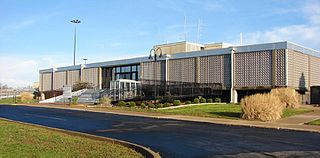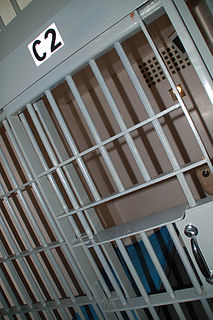
Solitary confinement is a form of imprisonment distinguished by living in single cells with little or no meaningful contact to other inmates, strict measures to control contraband, and the use of additional security measures and equipment. It is specifically designed for disruptive inmates who are security risks to other inmates, the prison staff, or the prison itself. It is mostly employed for violations of discipline, such as murder, hostage-taking, deadly assault, and rioting. However, it is also used as a measure of protection for inmates whose safety is threatened by other inmates.

The United States Disciplinary Barracks is a military correctional facility located on Fort Leavenworth, a United States Army post in Kansas.

Incarceration in the United States is one of the main forms of punishment and rehabilitation for the commission of felony and other offenses. The United States has the largest prison population in the world, and the highest per-capita incarceration rate. In 2018 in the US, there were 698 people incarcerated per 100,000; this includes the incarceration rate for adults or people tried as adults. In 2016, 2.2 million Americans have been incarcerated, which means for every 100,000 there are 655 that are currently inmates. Prison, parole, and probation operations generate an $81 billion annual cost to U.S. taxpayers, while police and court costs, bail bond fees, and prison phone fees generate another $100 billion in costs that are paid by individuals.

The United States Penitentiary, Administrative Maximum Facility is an American federal prison that provides a higher level of custody than a maximum security prison. It is classed as a supermax or "control unit" prison, where the safety of inmates and staff is paramount. It is located in unincorporated Fremont County, Colorado, near Florence, and opened in 1994, and it is informally known as the "Alcatraz of the Rockies".

Mississippi State Penitentiary (MSP), also known as Parchman Farm, is a maximum-security prison farm located in unincorporated Sunflower County, Mississippi, in the Mississippi Delta region. Occupying about 28 square miles (73 km2) of land, Parchman is the only maximum security prison for men in the state of Mississippi, and is the state's oldest prison.

Prison education is any educational activity that occurs inside prison. Courses can include basic literacy programs, secondary school equivalency programs, vocational education and tertiary education. Other activities such as rehabilitation programs, physical education and arts and crafts programs may also be considered a form of prison education. Programs are typically provided, managed and funded by the prison system, though inmates may be required to pay for distance education programs. The history of and current practices in prison education vary greatly among countries.

A super-maximum security (supermax) or administrative maximum (ADX) prison is a "control-unit" prison, or a unit within prisons, which represent the most secure levels of custody in the prison systems of certain countries. The objective is to provide long-term, segregated housing for inmates classified as the highest security risks in the prison system and those who pose an extremely serious threat to both national and global security.

A prison cell, also known as a jail cell, is a small room in a prison or police station where a prisoner is held. Cells greatly vary by their furnishings, hygienic services, and cleanliness, both across countries and based on the level of punishment to which the person being held has been sentenced. Cells can be occupied by one or multiple people depending on factors that include, but are not limited to, inmate population, facility size, resources, or inmate behavior.
Pontiac Correctional Center, established in June 1871, is an Illinois Department of Corrections maximum security prison for adult males in Pontiac, Illinois. The prison also has a medium security unit that houses medium to minimum security inmates and is classified as Level 3. Until the 2011 abolition of the death penalty in Illinois, the prison housed male death row inmates, but had no execution chamber. Inmates were executed at the Tamms Correctional Center. Although the capacity of the prison is 2172, it has an average daily population of approximately 2000 inmates.

Menard Correctional Center, known prior to 1970 as Southern Illinois Penitentiary, is an Illinois state prison located in the town of Chester in Randolph County, Illinois. It houses maximum-security and high medium-security adult males. The average daily population as of 2007 is 3,410.

The United States Penitentiary, Marion is a medium-security United States federal prison for male inmates in unincorporated Williamson County, Illinois. It is operated by the Federal Bureau of Prisons, a division of the United States Department of Justice. The facility also has an adjacent satellite prison camp that houses minimum security male offenders.

The Texas Department of Criminal Justice (TDCJ) is a department of the government of the U.S. state of Texas. The TDCJ is responsible for statewide criminal justice for adult offenders, including managing offenders in state prisons, state jails, and private correctional facilities, funding and certain oversight of community supervision, and supervision of offenders released from prison on parole or mandatory supervision. The TDCJ operates the largest prison system in the United States.

Red Onion State Prison (ROSP) is a supermax state prison located in Wise County, Virginia, near Pound. Operated by the Virginia Department of Corrections (VADOC), it houses about 800 inmates. The prison opened in August 1998.

A prison, also known as a jail or gaol, penitentiary, detention center, correction center, correctional facility, lock-up or remand center, is a facility in which inmates are forcibly confined and denied a variety of freedoms under the authority of the state. Prisons are most commonly used within a criminal justice system: people charged with crimes may be imprisoned until their trial; those pleading or being found guilty of crimes at trial may be sentenced to a specified period of imprisonment. In simplest terms, a prison can also be described as a building in which people are legally held as a punishment for a crime they have committed.

Lesbian, gay, bisexual, and transgender (LGBT) prisoners often face additional challenges compared to non-LGBT prisoners. According to Just Detention International, LGBT inmates are "among the most vulnerable in the prison population". 67% of LGBT prisoners in California report being assaulted while in prison. The vulnerability of LGBT prisoners has led some prisons to separate them from other prisoners, while in others they are housed with the general population.

The Alcatraz Federal Penitentiary or United States Penitentiary, Alcatraz Island was a maximum security federal prison on Alcatraz Island, 1.25 miles (2.01 km) off the coast of San Francisco, California, United Stateeen the site of a fort since the 1850s; the main prison building was built in 1910–1912 as a United States Army military prison. The United States Department of Justice acquired the United States Disciplinary Barracks, Pacific Branch, on Alcatraz on 12 October 1933, and the island became a prison of the Federal Bureau of Prisons in August 1934 after the buildings were modernized and security increased. Given this high security and the island's location in the cold waters and strong currents of San Francisco Bay, prison operators believed Alcatraz to be escape-proof and America's strongest prison.
In most prisons, inmates are forbidden from possessing mobile phones due to their ability to communicate with the outside world and other security issues. Mobile phones are one of the most smuggled items into prisons. They provide inmates the ability to make and receive unauthorized phone calls, send email and text messages, use social media, and follow news pertaining to their case, among other forbidden uses.

Penal laborin the United States is explicitly allowed by the 13th Amendment of the U.S. Constitution: "Neither slavery nor involuntary servitude, except as a punishment for crime whereof the party shall have been duly convicted, shall exist within the United States, or any place subject to their jurisdiction." Unconvicted detainees awaiting trial cannot be forced to participate in labor programs in prison as this would violate the Thirteenth Amendment.

Dooly State Prison (DSP) is a medium security facility located in Unadilla, Georgia, United States. The complex began its construction in 1993 and opened in 1994. It houses male inmates who are not suitable for a county prison due to their offense or physical limitations, primarily sex offenders. It can house up to 1702 prisoners in dorms that are triple bunks, double bunks, with some single beds. There is a separate unit for incorrigible inmates.
Paid prison labour refers to the participation of convicted prisoners in either voluntary or mandatory paid work programs.















